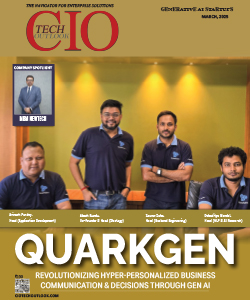Tech Landscape of In-Cabin Experiences and Safety in EV Industry
Sanjay Saha, India Country Manager, Synaptics
 Sanjay leads Synaptics' Wireless ASIC and Test Division, overseeing global Wi-Fi, Bluetooth, and GPS IoT products. With a background in engineering at Athena and Texas Instruments, he holds a B-Tech (Hons) Degree in Instrumentation Engineering from IIT Kharagpur, India, and multiple US patents in wireless communication.
Sanjay leads Synaptics' Wireless ASIC and Test Division, overseeing global Wi-Fi, Bluetooth, and GPS IoT products. With a background in engineering at Athena and Texas Instruments, he holds a B-Tech (Hons) Degree in Instrumentation Engineering from IIT Kharagpur, India, and multiple US patents in wireless communication.
In an interaction with CIOTechoutlook magazine, Sanjay highlighted the importance of in-cabin experiences in the EV industry, advancements in screens, connectivity, and safety features, the role of HMI technology in enabling OTA updates, and strategies for ensuring safety while meeting ambitious EV market share targets.
1. How do in-cabin experiences affect the EV industry's progress from concept to reality, and what upcoming trends will define these experiences in the future?
In-cabin experiences are going to play a crucial role in shaping the future of the electric vehicle (EV) industry. As consumers increasingly shift towards electric vehicles, their expectations for a seamless and enjoyable in-cabin experience will rise. This shift presents an opportunity for automakers to differentiate themselves by offering innovative, sustainable, and connected features within the vehicle.
Anticipated trends such as augmented reality (AR) interfaces, advanced touch and gesture controls, and immersive infotainment systems are on their way to become standard features. These advancements will not only enhance the overall driving experience but also contribute to greater safety and convenience. Personalization and connectivity will be another key trend, with in-cabin systems adapting to individual preferences, creating a truly tailored experience for each passenger. With seamless integration of IoT devices, enabling passengers to stay connected, productive, and entertained while on the move. These trends will not only impact consumer choices but also drive innovation and competition within the EV industry, pushing it closer to a sustainable and technologically advanced future.
2. How will further advancements in screens, connectivity, and safety features shape the automotive sector and enhance the driving experience?
Advancements in screens, connectivity, and safety features are poised to revolutionize the automotive sector and significantly elevate the driving experience. In fact, we at Synaptics, are deeply engaged in driving these transformations by using our HMI solutions like ADAS which further enables clear and easy-to-understand visual and auditory feedback, enhancing driver awareness and reducing the risk of road accidents. We also focus on gesture recognition and biometric authentication. Indeed, these solutions not only enhance security but also personalize the driving experience.
The integration of larger, higher-resolution displays will transform the vehicle's cockpit into a digital oasis, offering enhanced navigation, entertainment, and vehicle control options.Cameras, LiDAR, and radar sensors will work in harmony, providing 360-degree perception for the vehicle. AI and ML algorithms will enable predictive analytics, enhancing collision avoidance ultimately making roads safer and reduce accidents.Connectivity improvements like V2X (vehicle to everything) will enable seamless integration with the IoT, allowing for real-time traffic updates, remote diagnostics, and over-the-air software updates, thus keeping vehicles up-to-date and enhancing convenience.
These innovations collectively promise to make driving safer, more efficient, and more entertaining, ultimately reshaping the automotive landscape in the years to come.
3. How does HMI technology enhance EV solutions with OTA capabilities in the EV industry?
We design and developintuitive HMI solutions that include advanced controllers for touchscreens, display processors such as our SmartBridge SB9700that enhance display visibility. We also enable gesture recognition and voice control, interfaces. Human-Machine Interface (HMI) technology plays a pivotal role in the Electric Vehicle (EV) industry by serving as the bridge between the driver and the vehicle's complex systems. These interfaces make interactions with EVs user-friendly and efficient, enhancing the overall driving experience. We incorporate safety features such as driver monitoring and distracted driving detection that can be further improved and updated via OTA to adhere to evolving safety regulations and standards.
Moreover, by integrating Over-The-Air (OTA) capabilities, HMI technology enables EV manufacturers to remotely update software, fix bugs, and deliver new features, much like the smartphone industry's software updates. For OTA connections Synaptics provides the most advanced Wi-Fi and Bluetooth wireless solutions. In-vehicle Wi-Fi can connect to nearby infrastructure, home networks, or a smartphone to get OTA updates for the EV. It can also enable in-vehicle streaming to multiple displays simultaneously.
4. Could you suggest innovative approaches or technologies that prioritize both driver and passenger safety in modern EVs, emphasizing the safety factor?
Innovative approaches and technologies prioritizing driver and passenger safety in modern Electric Vehicles (EVs) are critical for ensuring the continued adoption of this sustainable transportation option. Our Driver Monitoring Systems (DMS) employ AI and sensors to monitor driver attentiveness, preventing drowsiness and distraction. Occupant monitoring systems detect passengers' presence and positions for improved airbag deployment in case of emergencies. Seamless in-cabin wireless connectivity ensure both a positive user experience for infotainment as well as enhanced safety through reliable connectivity.
5. How is the automotive sector overcoming the chip shortage crisis to advance ADAS features, and what strategies support the continuous development of these safety technologies?
Apart from strategies like diversifying chip suppliers, prioritizing production for safety-critical components, and optimizing chip usage in vehicles, automakers are also exploring long-term partnerships with semiconductor manufacturers to secure supply chains. Due to the lack of capital investment in legacy nodes, the semiconductor shortage might return. Therefore, it’s important for the industry remain committed to ADAS innovation by adapting, innovating, and collaborating to ensure the continuous evolution of these essential systems.
In the semiconductor industry, there's still a lot of inventory. Due to the shortage crisis faced in the COVID era, many companiesbought more than they needed. Hence, the strategy going forward for all such companies including us is how we deal with this inventory. While there’s no problem getting material for any customer in any sector, even automotive, however, we’re now in a period of highly pronounced inventory, though we see that inventory now decreasing quickly.
6. How can we ensure customer safety while meeting the ambitious 25% EV market share target by 2030 through the creation of interactive and connected environments?
To meet the ambitious30% for private cars; 70% for commercial vehicles and 80% for two and three-wheelersby 2030, while upholding safety standards, Synaptics recommends prioritising advanced HMIs that ensure intuitive, distraction-free interactions. Incorporate robust Driver Monitoring Systems (DMS) to ensure driver attentiveness. Strengthen cybersecurity measures to safeguard connected systems. Fostering collaboration with automakers can further create interactive and connected EV environments that meet both market targets and customer safety expectations.For instance, the SmartBridge, provides superior image quality, greater system implementation flexibility, and reduced device footprint, lower power consumption, and reduced system complexity for displays up to 30 inches and resolutions up to 6K.




.jpg)